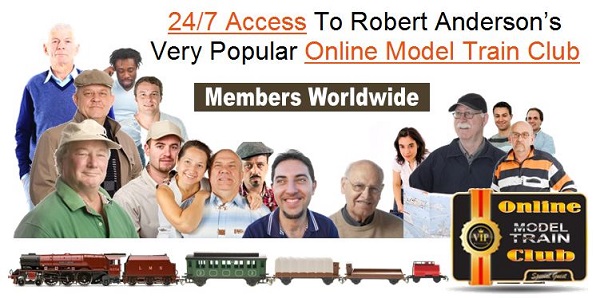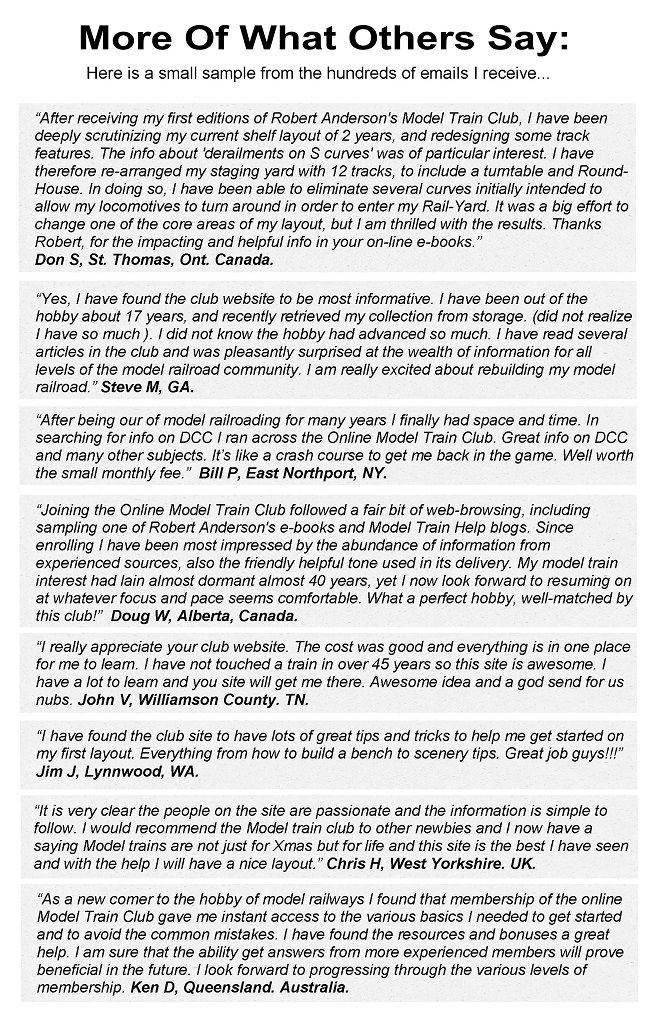|
|

Get 24 hour, 7 day a week access to hundreds of useful
model railroading resources and "step by step" easy to follow
tutorials to assist you in building a better model railroad. See how the
experts from around the world solve common (and not so common) problems to help you
build a better looking, smoother operating model train layout. You'll gain VIP
access to the numerous resources, "how-to" videos, and helpful new tutorials
added each month.

|
More On DCC Model Trains


Where to begin with building or just planning a
model railroad
Before you start constructing your model railway you will need to contemplate some
key concepts. These concepts will help you to gain an overall view of what your model railway is
for, its true function, where it will be placed, and how it will run. There are plenty of logistics
behind these concepts, so let’s discuss them below.
Scaling size and space:
Size is probably the most important factor because it is based off of your
available space. The area that you will construct and place your model determines the size of scale
railway you have. Once you have determined the scale then you can begin the search for locomotives,
cars, track, and scenery that all fit to scale.
There are scales for all different sizes. The scaling system is the comparative
ratio between the model and the prototype. So the larger space you have to utilize, the larger
scale you can use, and vice versa.
The video clip below shows a "double-header" HO scale steam locomotive in action
with smoke bellowing from it as it powers along the track. Fun to watch!
Theme and setting:
Once you have determined the size your model is going to be then you can begin to
get detailed with you project. You have probably already thought of a good theme or general setting
for your model, that’s why you are building one in the first place. You will want to search for
track, locomotives, and scenery that fit that theme. This search could take some time, so be
patient in looking for all of the necessary components.
If you are on a tight budget you may not be able to theme every component perfectly
within your model. Themed sets can get rather expensive, so you may need to be flexible with your
model if you have a smaller amount of funds.
If you have the necessary funds, then take full advantage of your theme. Go all out
with your model. A few suggestions would be to pick a historical area, a particular era to model, a
train within a movie, or a completely fictional model. There endless possibilities, but remember
that the theme is important and will help you to stay on task and be organized. Plus, your friends
and family will be impressed when they see your themed creation.
Placing your model:
The size of your space is also important for this category. Where you place your
model determines the amount of space you have. Consider the following questions: is this model for
your kids or grandkids? Will this model be on display in your house? Will this model be for a
museum or building? Will this model be for sale?
Your answers to these questions will help determine the size and space of your
model. If your model is going to be placed within your house, you will most likely have a smaller
scale. Be careful though, if you have small children you don’t want the scale to be too small. Tiny
pieces can be very hazardous for small children, so please consider the scale first.
If your model is going to be placed within a museum or display in a building, then
you will probably have more space to work with. This will allow you to have a larger scale if you
desire, or a larger layout with a smaller scale. The dimensions of your area determine the
placement and size of your model.
Functionality:
The model that you choose to create should be based off of the audience. If the
audience is just you, the hobbyist, then you are free to do anything of your liking. If the
audience is your children, you will want to seek out their interests. The audience determines the
functions of your model.
Model Train Scales:
HO scale model railways are about half the size of O scale model railways and were
designed to fit in homes more practically than O scale models fit. HO scale model trains are
currently the most popular scale of model trains in both North America and continental Europe. In
Britain, however, OO gauge is still the most popular. HO Trains are 1:87 scale and the track rails
are spaced 16.5 mm (0.64961 in) apart.
In the United States, HO is typically written as the letters H and O, and
pronounced as the names of the letters. In Germany, and other countries, HO can also be written H0
(letter H, numeral 0). In Germany, H0 is pronounced, “hah-null”. The term or name “HO” came from
being approximately half the size of O scale model railways.
HO scale railways gained popularity in the United States in the late 1950s during
the time period when model railroads took a decline in sales as toys, and increased interest was
expressed in hobby railway building. As the demand increased for hobby railways, the demand for
realism also increased and HO scale model trains and matching scale scenery were able to fulfill
the need for realism. Although more delicate than 0 scale models, HO’s smaller size can be
conformed to include more details and scale miles than O scale railways in comparable spaces.
HO scale model train sets come in a few different set options, varying in how much
assembly is required. Ready to run sets are ready straight out of the box, while shake the box sets
require minor assembly. Craftsman kits require the most assembly and skill.
Modelers limited on space will often opt for the increasingly popular scale of N.
The N scale trains are not only considerable smaller, but it is possible to accomodate additional
track and scenery in a much smaller space. This makes the scale perfect for modelers in apartments,
condos etc. or where only a small bedroom is available. Z scale is even smaller if that interests
you.
|

